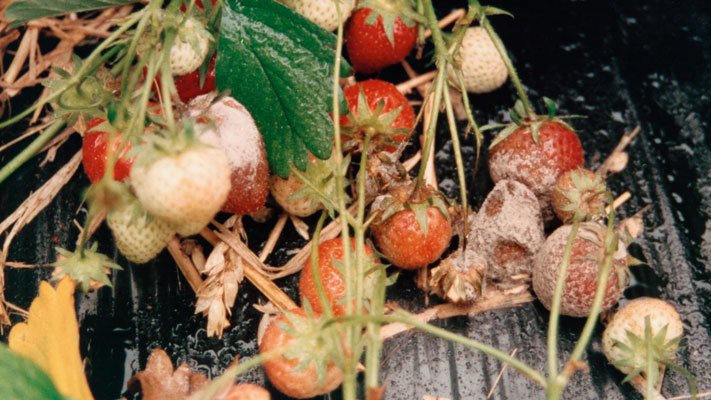Botrytis bunch rot
Often the most common and damaging of the bunch rot diseases, botrytis bunch rot can significantly reduce yield and quality of both wine grapes and table grapes. In wine grapes, botrytis is also known as grey mould, and produces an enzyme which in the presence of oxygen causes spoilage and may also give the wine a mouldy character.

Description
As there are a number of rots with similar symptoms that are described as bunch rot, it is essential to correctly identify the rot to ensure the correct management strategy is implemented.
While botrytis infection can occur at flowering, it is often not observed until closer to harvest when the symptoms become more noticeable on the fruit. The first signs of berry infection are where water-soaked spots appear and the skin easily slides off the fruit, known as ‘slip-skin’. When infected, the maturing berry changes colour and grey fungal growth appears. As the spores are released, the disease quickly spreads to other berries.
Conditions which result in persistent moisture on the berry surface favour the development of botrytis bunch rot i.e. high humidity or prolonged periods of rain.
Refer to the links below for more detailed information on Botrytis cinerea in other crops.
Control
There are a number of cultural preventative practices aimed at reducing the incidence and severity of the disease. These include;
- Remove bunch remnants and trash that may harbour the disease
- Minimising physical berry damage which aids the spread of the disease i.e. plant wind breaks
- Canopy management to reduce the density of fruit and foliage to improve air flow
- Manage nitrogen nutrition to minimise the risk of berry split
Botrytis can infect grapevines at any time during favourable conditions, however an effective preventative spray program is usually aimed at flowering, pre-bunch closure and pre-harvest. Fungicides should be alternated between different chemical groups.
Teldor®, Scala® and Serenade® Opti are registered for the control of bunch rot on grapevines. Serenade Opti is not systemic and will not control advanced infections but provides similar botrytis protection as registered synthetic products when used in a season-long preventative spray program. It is also safe on most beneficial insect species when used as directed.
References
Fisher, D, Gordon, C and Wood, P (2002), ‘Botrytis in wine grapes in Western Australia’, Department of Primary Industries and Regional Development (DPIRD), https://researchlibrary.agric.wa.gov.au/cgi/viewcontent.cgi?article=1092&context=bulletins
Taylor, A (2019) ‘Know your grapevine bunch rots’, Department of Primary Industry and Regional Development (DPIRD),
https://www.agric.wa.gov.au/summer/know-your-grapevine-bunch-rots








